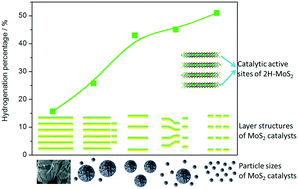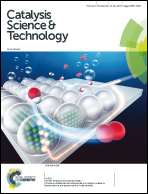Designing MoS2 nanocatalysts with increased exposure of active edge sites for anthracene hydrogenation reaction†
Abstract
Designing MoS2 nanocatalysts rich with active edge sites by engineering of the nanostructures is an effective strategy to enhance their catalytic activity. A series of MoS2 nanoflowers with self-assembled nanosheets was successfully synthesized by engineering of nanostructures. The compositions and structures of MoS2 nanoflowers were characterized by elemental analysis, XPS, TG, XRD, Raman, SEM, and HRTEM. The growth mechanism for MoS2 samples was proposed. MoS2 nanoflowers with a short slab of 5–10 nm, 3–5 stacking layers and expanded basal spacing of 0.98 nm were synthesized via a one-pot solvothermal synthesis method using high boiling point and viscosity ethylene glycol as solvent, maximizing the exposure of active edge sites. In the catalytic anthracene hydrogenation reaction in a slurry-phase reactor, the hydrogenation percentage and selectivity to deep hydrogenation products of the optimized MoS2 nanoflowers are respectively 3.2 times and 31.2 times as high as those of commercial MoS2. The structure–activity relationship of MoS2 catalysts suggests that the engineering of nanostructures to increase the exposure of active edge sites can dramatically improve the catalytic hydrogenation performance of MoS2 catalysts. This study provides the theoretical instructions for designing MoS2 catalysts with improved activity. The increased understanding and research on MoS2 catalysts will drive the industrialization of heavy oil/residue conversion into clean fuels.

- This article is part of the themed collection: 2017 Catalysis Science & Technology HOT Articles


 Please wait while we load your content...
Please wait while we load your content...